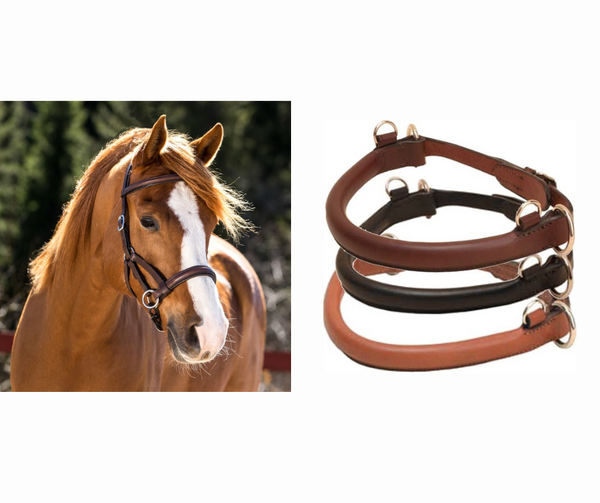I’m going to get real with you guys today… my horse Mira HATES bits… and when I say bits, I mean ALL bits. Ever since I broke her out as a baby, she despised anything being in her mouth.
Of course, I had her checked out by the dentist and her teeth were totally fine. Turns out she just has a super low palette and thick tongue, aka her tongue takes up so much space in her mouth that there isn’t enough room for a bit to sit comfortably. This led me on a multi year-long search of finding a bit that Mira would potentially tolerate.
Believe me, when I say I tried just about everything- french links, waterfords, thick mouthpieces, thin mouthpieces, rubber, copper, leather, even a custom low wide port (my bank account just about had a stroke)… she hated every one of them.
It used to be my goal to get her in the hunter ring at some point (this was before it became painfully obvious she’d never be a hunter), so it didn’t register in my brain to try a hackamore, but one day I finally said, “What the heck!” and threw her in one. It was almost like I had a different horse… I mean it wasn’t completely perfect, but Mira was definitely a happier camper!
This then spurred me into researching all the different bitless options for her because I couldn’t be settled until I found just the right one.
So, today I thought I would share some of my bitless knowledge with you so you don’t have to jump through all the hoops I did (thanks Mira)!

Types of Bitless Bridles
Mechanical Hackamore
The most common/popular bitless option is the mechanical hackamore. A mechanical hackamore consists of a noseband, two metal shanks, and a curb chain. The noseband goes over the horse’s nose, connects to the two shanks on each side of the face and then the curb chain connects to the shanks under the horse’s chin. The complete hackamore then attaches to the headstall of a bridle and with the addition of reins, works off nose, poll, and chin pressure to guide the horse.
When pressure is applied to the reins, there is a leverage action on the poll in addition to the direct nose and curb pressure. Because of this, hackamores can be considered a strong “bit” if used in inexperienced hands but can be a great option for horses that prefer poll pressure. The type of noseband and curb chain will also affect the harshness.
Mira is a pretty sensitive mare, so she found a lot of the traditional mechanical hackamores a little too strong for her liking. But luckily there are so many different features now to choose from so you can find just the right combination.
Shank Length-
The severity of the hackamore directly relates to the length of shanks… the longer the shanks, the more leverage it will have and the stronger it will be.
The standard length to start with is about 7” shanks and you can move shorter or longer from there depending on your needs.
A great basic one is the Centaur Fleece Lined Hackamore. This is what most people immediately think of when you say hackamore.
Nunn Finer makes a lot of great options with shorter shanks!
The Crossroads Hackamore has 4 ¼” shanks so will offer a softer leverage action.
Whereas this Metalab Hackamore has 8 ½” shanks and offers much more leverage.
Noseband-
Another factor that will affect the severity of a hackamore is the type of noseband. Types such as rope or chain will be harsher as opposed to a padded leather or fleece-lined one.
Curb Chain-
Finally, there are two main types of curb chains for hackamores. Chain and leather. A leather curb will be softer than a chain. But there are plenty of little tricks to make a chain softer, such as a curb chain cover, or my personal favorite just some Sealtex (my answer to basically anything in life is “add some sealtex!”).
Mechanical hackamores are popular in all disciplines but are used most often with showjumpers and barrel racers.
Side Pull
A side pull is another common bitless bridle and works off direct nose pressure. It is basically the equivalent of attaching reins to a halter. There is no leverage action with this type of bitless bridle. The noseband comes in a variety of different materials, such as rope or leather, and has a metal ring on each side that you attach the reins to.
Scrawbrig
Similar to a sidepull, a scrawbrig combines both nose and chin pressure. It features a side-pull noseband as well as a strap of leather with two rings that connect under the chin. The reins then attach to the piece of leather under the chin so when the reins are pulled there is chin pressure in addition to nose pressure.

Cross Under
Crossunder bitless bridles resemble sidepulls but have two straps that “cross under” the horse’s jaw to apply pressure to the whole head as opposed to just the nose. The reins then attach to those straps, so for instance, when you pull on the right rein, it exerts pressure on the left side of the horse’s face to guide them in the right direction.

Bosal
Bosal’s are most commonly used in the western industry to break and show colts. Typically they have a braided rawhide noseband that ends in a knot. From that knot is where the mecate reins attach. Mecate reins are a single long piece of rope that when tied creates a looped rein as well as a free end that can be used for leading or lunging. Instead of independent side pressure that comes from a sidepull, bosals encourage flexion and softness by putting pressure on the opposite side of the face.

Convertible
A great versatile option for bitless is using a convertible bridle such as the Rambo Micklem Multibridle! Not only can this bridle be used traditionally with a bit, but it also converts into a sidepull or scrawbrig.
There are multiple convertible hackamores out there as well that allow you to change the placement of the reins on the shank to give more or less leverage.
Mira’s Favs
PS of Sweden Hackamore Sport Bridle–
This is Mira’s favorite hackamore because it gives just the right amount of leverage but her special sheepskin lining on the noseband keeps her nose extra comfy. Plus the anatomical headstall ensures that the cheekpieces stay out of her eyes.
Wheel or Convertible Hackamore
I’ll sometimes switch back and forth between her regular hackamore and this wheel hackamore because sometimes the longer shanked one becomes a little too strong for her. When that happens, I throw her in our wheel hackamore that I found deep in the European interwebs so she doesn’t bury herself behind it. The Nunn Finer Multiple Choice Hackamore is a great American alternative because it features so many different options to attach the reins and curb chain to.
Hackamore “Hacks”
-Horse getting rubs from the noseband, and you don’t have fleece cover handy? Take a washcloth, fold in half and then roll it around the hackamore, securing it with a strip of vet wrap or Sealtex. Instant hackamore cover!

-Wrap a chain curb chain in Sealtex to make it softer and more comfortable for your horse.
-If the cheekpieces of your bridle are falling into your horse’s eyes, attach an old number string that you can run under your horse’s jaw from one cheek piece to the other. This will help keep the bridle in place!

Over the years, every once and a while when someone suggests a new one, I will throw Mira back in a bit with the hopes she may take a liking to it. But I’ve had no avail so far and I’ve faced the music that I will always have a quirky little mare and that’s okay! I’d rather her be happy while being ridden instead of her more closely resembling an angry giraffe (I’m not kidding in the slightest). So if you have a horse that you are struggling to find a suitable bit for, give me a shoutout and maybe I can offer some suggestions!









1 comment
I am thrilled to have come across your article. I have a 6 y.o. OTTB mare. She is kind, considerate and wants to do what is asked of her. She is a “throw away” from the Fingers Lakes. I can’t imagine what she has been through though I do know she only raced twice, worked in a tongue tie down, is a windsucker so wears a miracle collar. Both the chiropractor and dentist have commented to me she has an incredibly tight jaw along with the muscle tension from cribbing. I have gone through the same frantic buying of bits and bridles as you described. This week I gave up and rode her in a rope halter that I attached reins to. Some of the best rides we have had. Now I need advice of a bitless bridle. I am grateful for any advice you can give.